![]()
![]()
![]()
Use LEFT and RIGHT arrow keys to navigate between flashcards;
Use UP and DOWN arrow keys to flip the card;
H to show hint;
A reads text to speech;
92 Cards in this Set
- Front
- Back
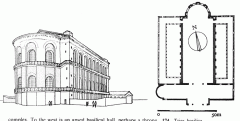
|
Aula Palatina, at the Palace of Constantine, Trier, Germany, early fourth century
|
|

|
Arch of Constantine, Rome, 312-15
|
|
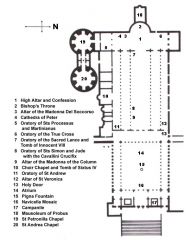
|
Old St. Peter’s, Vatican Hill, Rome, begun ca. 320
|
|
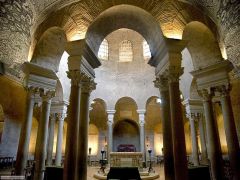
|
Sta. Costanza, Rome, ca. 337-351
|
|

|
Baptistery, at San Giovanni in Laterano, Rome, fourth century
|
|
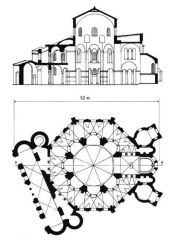
|
San Vitale, Ravenna, 526-547
|
|

|
Justinian and His Retinue, mosaic in apse, Church of San Vitale, Ravenna, ca. 547
|
|

|
Anthemius of Tralles and Isodorus of Miletus, archs., Hagia Sophia, Constantinople, 532-537
|
|
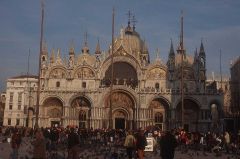
|
Basilica San Marco (St. Mark’s), Venice, begun 1063-1094
|
|
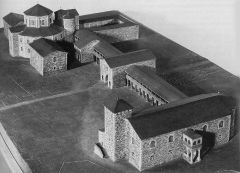
|
Odo of Metz, arch., Palatine Chapel, at Palace of Charlemagne, Aachen (Aix-la-Chapelle), Germany, 792-805
|
|
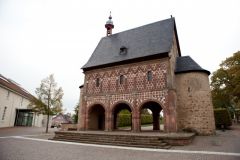
|
Torhalle (Gatehouse), monastery at Lorsch, Germany, ca. 767-74
|
|
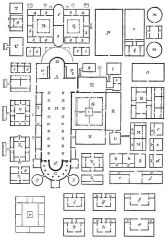
|
Ideal plan for a monastery, from St. Gall, Switzerland, ca. 820
|
|
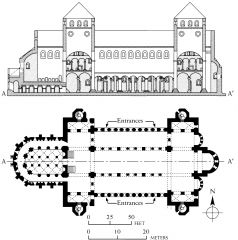
|
St. Michael’s Church, Hildesheim, Germany, 1001-31
|
|
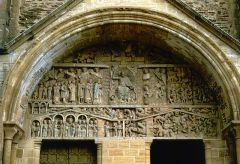
|
Sainte-Foy, Conques, France, ca. 1050-1130
|
|
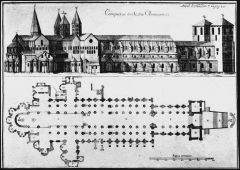
|
Third Abbey Church (“Cluny III”), Cluny, France, 1088 - ca. 1121
|
|

|
Abbey Church of Notre-Dame, Fontenay, France, ca. 1139-47
|
|
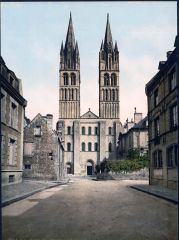
|
St.-Étienne, Caen, France, 1068-1120
|
|
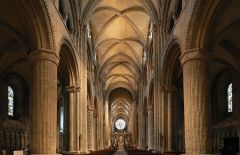
|
Cathedral of St. Cuthbert, Durham, England, 1093-1133
|
|
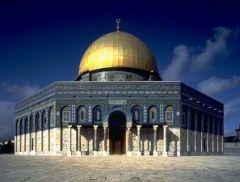
|
Dome of the Rock, Jerusalem, 687-692
|
|
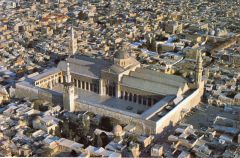
|
Great Mosque, Damascus, Syria, ca. 706-715
|
|
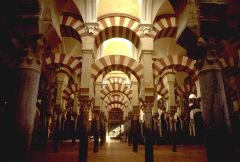
|
Great Mosque, Córdoba, Spain, 786, 833-988
|
|

|
Abbey Church of Saint-Denis, Saint-Denis, France, Narthex and west façade, 1137-40; chevet, 1140-44
|
|
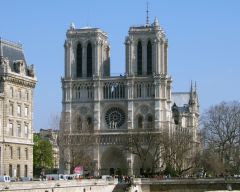
|
Cathedral of Notre Dame, Île-de-la-Cité, Paris, France, begun 1163; flying buttresses ca. 1180-1220
|
|

|
Chartres Cathedral, Chartres, France, begun 1134; rebuilt after 1194
|
|
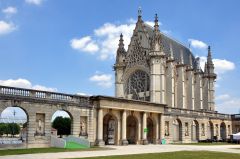
|
Sainte-Chapelle, Île-de-la-Cité, Paris, France, 1243-48
|
|
|
ambulatory
|
a semicircular or polygonal passageway around an apse.
|
|
|
apse
|
a vaulted semicircular or polygonal termination.
|
|
|
arcade
|
a covered passageway with arches along one or both sides.
|
|
|
archivolts
|
the continuous molding framing an arch. In Romanesque or Gothic architecture, one of a series of concentric bands framing the tympanum.
|
|
|
baldacchino
|
a canopy on four columns, frequently built over an altar. Also referred to as a ciborium.
|
|
|
banded barrel vault
|
a barrel vault stiffened at intervals by diaphragm arches.
|
|
|
baptistery
|
in Christian architecture, the building used for baptism, usually situated next to a church.
|
|
|
basilican-plan church
|
in Christian architecture, a church somewhat resembling the Roman basilica, usually entered from one end and having an apse on the other.
|
|
|
Byzantine Empire
|
a continuation of the Roman Empire in the Middle East after its division in 395
|
|
|
El Camino de Santiago (Way of Saint James)
|
The Way of St. James or St. James' Way is the pilgrimage route to the Cathedral of Santiago de Compostela in Galicia in northwestern Spain, where tradition has it that the remains of the apostle Saint James are buried.
|
|
|
chancel/chevet
|
a French term used to describe the east end of a church, usually a Romanesque or Gothic church, with its apse, ambulatory, and radiating chapels; also known as a chancel.
|
|
|
Cisterian Order
|
They are variously called the Bernardines, after the highly influential St. Bernard of Clairvaux. The original emphasis of Cistercian life was on manual labour and self-sufficiency, and many abbeys have traditionally supported themselves through activities such as agriculture and brewing ales. Over the centuries, however, education and academic pursuits came to dominate the life of their monasteries. The keynote of Cistercian life was a return to literal observance of the Rule of St Benedict exactly as it had been in Saint Benedict's time.
|
|
|
Cluniac Order
|
While most Benedictine monasteries remained autonomous and associated with each other only informally, Cluny created a large, federated order in which the administrators of subsidiary houses served as deputies of the Abbot of Cluny and answered to him. At Cluny, the central activity was the liturgy; it was extensive and beautifully presented in inspiring surroundings, reflecting the new personally-felt wave of piety of the 11th century. Monastic intercession was believed indispensable to achieving a state of grace, and lay rulers competed to be remembered in Cluny's endless prayers; this inspired the endowments in land and benefices that made other arts possible.
|
|
|
colonette
|
a thin column.
|
|
|
compound pier
|
a pier with a group, or cluster, of attached shafts or responds (such as pilasters, engaged columns).
|
|
|
cupola
|
a small dome, esp. a small dome on a drum on top of a larger dome, adorning a roof or ceiling.
|
|
|
Dark Ages
|
Middle Ages: the period of history between classical antiquity and the Italian Renaissance
|
|
|
dosseret
|
a French term for an additional high block or slab set on top of an abacus and placed between it and the spandrel of an arch above; also called a super-abacus. Common in Byzantine work, and found in some Romanesque buildings.
|
|
|
Early Gothic
|
Other characteristics of early Gothic architecture, such as vertical shafts, clustered columns, compound piers, plate tracery and groups of narrow openings had evolved during the Romanesque period.
|
|
|
Flamboyant
|
“flame-like.” A Late Gothic style of architecture, superseding the Rayonnant style, and named for the flame-like appearance of its pointed bar tracery.
|
|
|
gallery
|
a balcony, esp. a platform or upper floor, projecting from the back or sidewall inside a church or hall, providing space for an audience or musicians.
|
|
|
High Gothic
|
Supposedly ‘classic’ period of Gothic architecture, embracing Northern French Cathedrals erected c.1195–c.1230 (e.g. Chartres, Rheims, Amiens, and Soissons).
|
|
|
historiated capital
|
ornamented with representations, such as animals or human figures, that have a narrative—as distinct from a purely decorative—function.
|
|
|
Holy Roman Empire
|
a political entity in Europe that began with the papal coronation of Otto I as the first emperor in 962 and lasted until 1806 when it was dissolved by Napoleon
|
|
|
Ile de France
|
Île-de-France is the wealthiest and most populated of the twenty-seven administrative regions of France
|
|
|
jamb and jamb sculpture
|
the side post of a doorway.
|
|
|
Kufic script
|
a calligraphic form of Arabic script.
|
|
|
Laborum (Chi-Rho)
|
the monogram of Constantine; a symbol composed of the two first letters in Christ’s name in the Greek.
|
|
|
mihrab
|
a semicircular niche set into the qibla wall of a mosque, believed to represent the space where Muhammed stood in his house in Mecca when he led prayer there.
|
|
|
minaret
|
TOWER! you pray from it or something.
|
|
|
mosque
|
a Muslim place of worship.
|
|
|
nave
|
the central area of an ancient Roman basilica or of a church, demarcated from aisles by piers or columns separating the nave from the aisles.
|
|
|
palatine
|
(of an official or feudal lord) having local authority that elsewhere belongs only to a sovereign.
|
|
|
pendentive
|
an inverted, concave, triangular piece of masonry serving as the transition from a square support system to the circular base of a dome.
|
|
|
pilgrimage church
|
visited by Christians for prayer. It is believed that any prayers made in the shrines found in these churches reach God more quickly and that He would also heal them of their ailments.
|
|
|
plate tracery
|
window tracery in which the designs have been carved from a flat plate of stone rather than constructed from bars, characteristic of early Gothic
|
|
|
pointed arch
|
an arch with a pointed crown, characteristic of Gothic architecture.
|
|
|
qibla
|
the direction (towards Mecca) Muslims face when praying.
|
|
|
radiating chapel
|
in medieval churches, chapels for the display of relics that opened directly onto the ambulatory or transept.
|
|
|
rayonnant
|
“radiant.” A Late Gothic style of architecture characterized by greater emphasis on light and glazing, with windows seemingly taking over walls. The greater window area was enabled by the invention and use of bar tracery. The Rayonnant is dominant in the second-half of the thirteenth century and is associated with the French royal court of Louis IX in Paris.
|
|
|
relic
|
the body parts, clothing, or objects associated with a holy figure, such as a Christian saint.
|
|
|
renovatio imperii romani
|
Latin for the Renovation of the Roman Empire. The king of (modern day) France had defeated the Saxons and Gauls and took over Rome and was going to renovate the Roman Empire. Even after the fall of the Roman empire people were still crowned Holy Roman Emperor. Like Charlamane who was crowned on Christmas day.
|
|
|
rib
|
a projecting band on a ceiling or vault, usually structural but sometimes purely decorative, separating the cells of a groined vault.
|
|
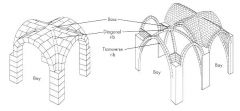
ribbed groin vault
|
Ribbed groin vaults are also known as cross vaults. Ribbed groin vaults replaced Romanesque barrel vaults as the means to cover the nave because ribbed groin vaults allow the addition of clerestory windows. Placing two barrel vaults at right angles creates groin vaults
|
|
|
ribbed pointed-arch vault
|
with pointed arches instead
|
|
|
rule of St. Benedict
|
a legislative code for the organization and operation of monastic institutions, written by Benedict of Nursia; largely responsible for the organization and spread of monasticism in the west.
|
|
|
scholasticism
|
The dominant western Christian theological and philosophical school of the Middle Ages, based on the authority of the Latin Fathers and of Aristotle and his commentators.
|
|
|
squinch
|
a straight or arched structure across an interior angle of a square tower to carry a superstructure such as a dome.
|
|
|
Synod of Whitby
|
the synod held in 664 at Whitby at which the Roman date for Easter was accepted and the Church in England became aligned with Rome
|
|
|
triforium
|
a gallery or arcade above the arches of the nave, choir, and transepts of a church.
|
|
|
trumeau
|
in church architecture, the pillar or center post supporting the lintel in the middle of a doorway.
|
|
|
tympanum
|
the space enclosed by a lintel and an arch over a doorway.
|
|
|
Vitruvian man
|
The Vitruvian Man is a drawing created by Leonardo da Vinci circa 1490. It is accompanied by notes based on the work of the architect Vitruvius
|
|
|
westwork
|
tower-like western-end to a church, containing an entrance vestibule with a chapel over it.
|
|
|
Abbe Suger
|
Suger was one of the last Frankish abbot-statesmen, a historian, and the influential first patron of Gothic architecture.
|
|
|
Abbot Hugh
|
canonized by the Roman Catholic Church as Saint Hugh (the Great). He was one of the most influential leaders of one of the most influential monastic orders of the Middle Ages. Cluny III
|
|
|
Anthemius of Tralles
|
Greek professor of Geometry in Constantinople and architect, who collaborated with Isidore of Miletus to build the church of Hagia Sophia by the order of Justinian I.
|
|
|
Bernard of Clairvaux
|
French abbot and the primary builder of the reforming Cistercian order.
|
|
|
Bishop Bernward
|
thirteenth Bishop of Hildesheim. Hildesheim was a center of power in the Holy Roman Empire and Bernward was determined to give his city an image fitting for one of its stature. The column he planned on the model of Trajan's Column at Rome never came to fruition, but Bernward revived classical precedent by having his name stamped on roof tiles made under his direction. Bernward built up the cathedral district with a strong twelve-towered wall and erected further forts in the countryside to protect against attacks by the neighboring Slavic peoples. Under his direction arose numerous churches and other edifices, including even fortifications for the defence of his episcopal city against the invasions of the pagan Normans. He protected his diocese vigorously from the attacks of the Normans.
|
|
|
Charlemagne
|
King of the Franks from 768, the King of Italy from 774, and from 800 the first emperor in western Europe since the collapse of the Western Roman Empire three centuries earlier. The expanded Frankish state he founded is called the Carolingian Empire.
|
|
|
Constantine
|
Roman Emperor from 306 to 337. He built a new imperial residence at Byzantium and named it New Rome. However, in Constantine's honor, the Romans called it Constantinople, which would later be the capital of what is now known as the Byzantine Empire for over one thousand years. Because of this, he is thought of as the founder of the Byzantine Empire. His more immediate political legacy was that, in leaving the empire to his sons, he replaced Diocletian's tetrarchy with the principle of dynastic succession.
|
|
|
Isodorus of Miletus
|
one of the two main Byzantine Greek architects (Anthemius of Tralles was the other) that Emperor Justinian I commissioned to design the church of Hagia Sophia in Constantinople from 532-537 A.D.
|
|
|
Justinian
|
was Byzantine Emperor from 527 to 565. During his reign, Justinian sought to revive the Empire's greatness and reconquer the lost western half of the historical Roman Empire.
|
|
|
Marcus Vitruvius Pollio
|
Roman author, architect, and engineer during the 1st century BC perhaps best known for his multi-volume work entitled De Architectura.
|
|
|
Odo of Metz
|
an architect who lived during Charlemagne's reign in the Carolingian Empire. Basilica of San Vitale of Ravenna and late Roman architecture with Byzantine style. architect of Charlemagne's Palace of Aachen with the Palatine Chapel, in Aachen.
|
|
|
Otto III
|
Holy Roman Emperor from 996 until his early death in 1002. Otto III's actions throughout his life further strengthened imperial control over the Catholic Church.
|
|
|
Villard de Honnecourt
|
His drawing of one of the west facade towers of Laon Cathedral and those of radiating chapels and a main vessel bay, interior and exterior, of Rheims Cathedral are of particular interest.
|

